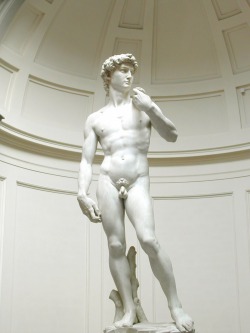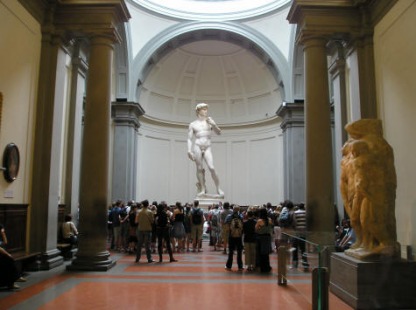Although I have heard and seen the Statue of David in pictures and the internet, I wasn’t too excited as I was seeing the Mona Lisa in Paris. Why? Only because I thought it was a simple statue of a man exposing himself, an ordinary sculpture of a famous Bible character. In fact, I even found Donatello’s hermaphroditic more interesting. I mean who wouldn’t? I really thought it could pass as the statue of Joan of Arc minus the giant’s decapitated head. But not until, we’ve actually been in the Accademia I’ve realized how this statue of a naked man meant so much for the Florentine’s and how this statue has been considered one of the greatest.
Sitting right smack in the middle of the Accademia, no one can miss the glory of David not even for a complete novice in art like me. It stands 17’ tall perhaps originally shorter, shining under the rays of light striking against the dome. Looking closer, the white marble seemed so preserved and clean without the use of any glossing material. David’s stance also reminds me so much of one unique quality of the Italians, the “Sprezzatura,” which meant the ability of an Italian man to stand with poise, elegance and sophistication without doing nothing, with nonchalance. Exactly, Italians hold the ability to just stand there. Not caring, just staring, somewhat contemplating. It is indeed a unique, endearing quality no other nationality possesses. Similarly, David holds that elegance and poise. Michaelangelo’s wonderful grasp of marble, shaping and molding the stone into muscle evokes such a fluid motion of a man just standing. David’s slightly creased eyebrows and his empty eyes looking so faraway shows him a man in deep thought. What was he planning to do? What was he doing? Was he thinking of a way to beat Goliath? Was he, in a more spiritual sense, simply trusting in God? Perhaps not in Michaelangelo's mind. Gripping a rock in his left hand, while his right rests on a slingshot, Michaelangelo captures David's slightly popping vein while grasping such two symbolic objects of the story. A beautiful, still stature of humanity.
In comparison to the other David’s I’ve seen, Michaelangelo’s lacks the head of the fallen Goliath. According to the Accademia’s description (in my own words now), the reason being Goliath was opted out of the picture, was to express the young king having beaten Goliath through mere intellect rather than brute force. An interesting interpretation indeed. Although, I have one thing against Michaelangelo’s interpretation. David in this statue, looks so much more like a “man” than a young passionate, shepherd boy. But then again, was this an interpretation after the fact that David had long defeated Goliath? And oh yes, the rock and sling...what is it really? As you might know, this sling and rock wraps and connects around his back. So many have asked, is it a rock? a sling? But I guess, that is what makes this Statue such a great work of masterpiece. A work of art subject to anyone’s interpretation. But at the end of the day, whatever the controversies behind this piece are, all I could do was stare in wonder and in awe. The Statue of David in craftsmanship, skill and quality is one of the world's finest. Ralph had to literally pull me away to take my eyes off of it.




 RSS Feed
RSS Feed